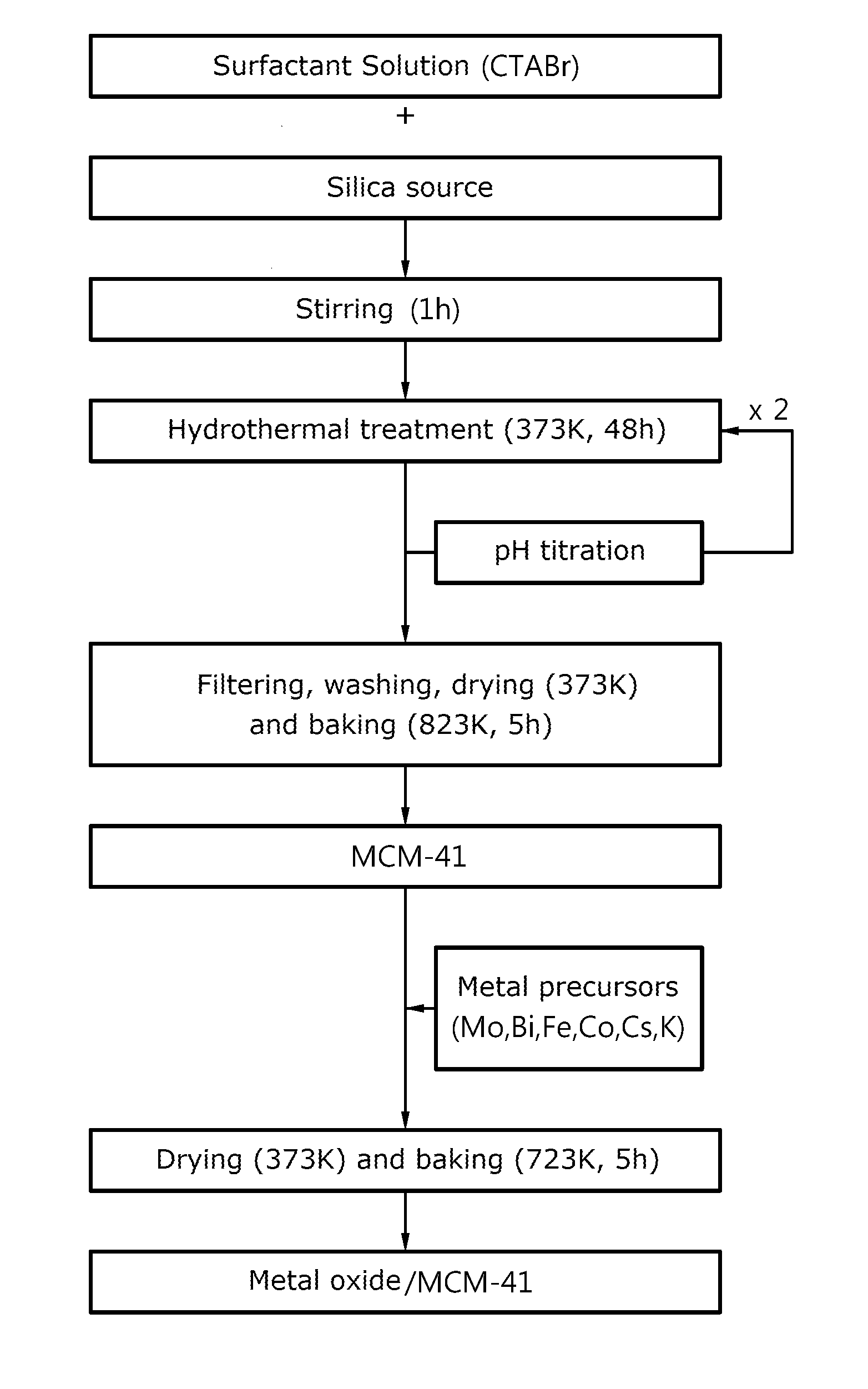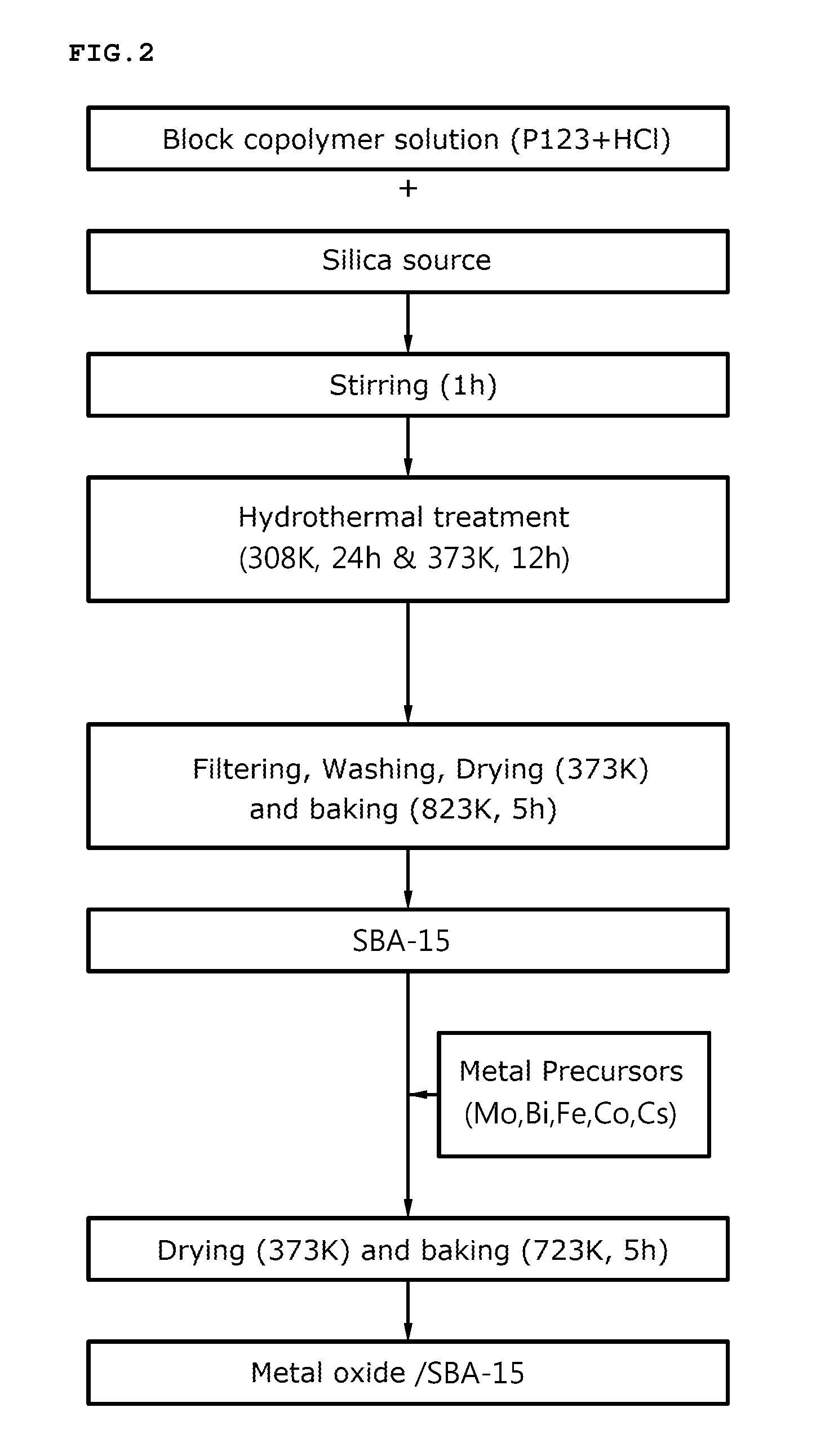Mesoporous composite oxide catalyst, method for preparing the same and method for synthesizing 1,3-butadiene using the same
- Summary
- Abstract
- Description
- Claims
- Application Information
AI Technical Summary
Benefits of technology
Problems solved by technology
Method used
Image
Examples
example 2
[0089]For preparation of porous silica, the triblock copolymer (produced by BASF Corp.) of poly(ethylene glycol)-poly(propylene glycol)-poly(ethylene glycol) was dissolved in a 40° C. hydrochloric acid solution, and tetraethylortho silicate (TEOS) was added to the solution and was stirred for one hour to prepare an emulsion.
[0090]The emulsion was thermally treated at 40° C. for 24 hours and at 100° C. for 12 hours, to prepare a silica mixture solution. The silica mixture solution was filtered, washed with distilled water or ethanol and dried at 100° C. to obtain a solid sample.
[0091]The solid sample was baked in an electric furnace at 550° C. for 5 hours and the prepared silica was added to the metal precursor solution using Cs as E in Formula 1 to prepare a composite oxide catalyst.
[0092]For reference, as the metal precursors, cobalt nitrate (Co(NO3)2.6H2O), iron nitrate (Fe(NO3)3.9H2O), bismuth nitrate (Bi(NO3)2.5H2O), cesium nitrate (CsNO3) and ammonium molybdate ((NH4)6Mo7O24.4H...
application example
[0112]75 mL of the 60 wt % MoBiFeCoCs+40 wt % SiO2 mesoporous composite metal oxide catalyst obtained in Examples 1 and 2 and 75 mL of the composite metal oxide catalyst obtained in Comparative Example 1 were charged in a metal tubular reactor as a fixed bed and catalyst activity of the catalysts were measured.
[0113]Normal-butene was fed into the reactor together with oxygen, nitrogen and steam, a molar ratio of butene to oxygen to nitrogen to steam was set at 1:0.5:8:5 and space velocity (GHSV) was 250 h−1 based on normal-butene.
[0114]A butane flow was controlled using a mass flow controller (MFC) for liquid, oxygen and nitrogen was fed using a mass flow controller for gas, and steam was injected using a liquid pump. The steam was injected as water using a vaporizer, vaporized at 200° C. and was injected into the reactor as a mixture with other reactants, butene, oxygen and nitrogen.
[0115]The catalyst was pre-treated at 400° C. for 2 hours under an air atmosphere before injection o...
PUM
| Property | Measurement | Unit |
|---|---|---|
| Temperature | aaaaa | aaaaa |
| Temperature | aaaaa | aaaaa |
| Temperature | aaaaa | aaaaa |
Abstract
Description
Claims
Application Information
 Login to View More
Login to View More - R&D
- Intellectual Property
- Life Sciences
- Materials
- Tech Scout
- Unparalleled Data Quality
- Higher Quality Content
- 60% Fewer Hallucinations
Browse by: Latest US Patents, China's latest patents, Technical Efficacy Thesaurus, Application Domain, Technology Topic, Popular Technical Reports.
© 2025 PatSnap. All rights reserved.Legal|Privacy policy|Modern Slavery Act Transparency Statement|Sitemap|About US| Contact US: help@patsnap.com



